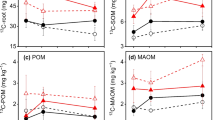Summary
The term relative nutrient requirement is introduced in order to measure and to compare the nutrient losses from different perennial plant populations and the amount of nutrient that they need to absorb to compensate these losses. The relative nutrient requirement (L) is defined as the amount of the growth-limiting nutrient that must be taken up to maintain or replace each unit of biomass during a given time interval (e.g., mgN g-1 biomass year-1). It is derived that in a plant community with two competing perennial plant populations, species1 will become dominant if the relative competition coefficient k 12 (sensu De Wit 1960) exceeds the ratio between the relative nutrient requirements of the two species (L 1/L 2), whereas species 2 will become dominant, if k 12 is below this critical ratio. The above-ground litter production was measured inwet heathland communities dominated by Erica tetralix or by Molinia caeruleain order to estimate N and P losses from theaboveground biomass and to calculate the relative N and P requirements of these species. Molinia lost during one year 63% and 34%, respectively, of the amount of N and P present in the above-ground biomass at the end of the growing season. These losses were in Erica 27% and 31%, respectively. The relative N requirements of the two species show the same difference: 7.5 and 2.6 mg N g-1 yr-1, respectively, in Molinia and in Erica. Also the relative P requirement of Molinia is higher as well as that of Erica (0.18 versus 0.08 mg P g-1 yr-1). The relative competition coefficient of Molinia with respect to Erica (k me ) is equal to unity under unfertilized conditions but increases with increasing nutrient supply. Under nutrient-poor conditions k me is below the critical ratio of the relative nutrient requirements of the two species (L m /L e =2.9 or 2.3), so that Erica will be the dominant species. After an increase in nutrient availability k me increases and exceeds this critical limit which results in Molinia replacing Erica. During the last 20 years this replacement of Erica-dominant communities by monocultures of Molinia has been observed in almost all wet heathlands in The Netherlands along with a strong increase in nitrogen availability.
Similar content being viewed by others
References
Bannister P (1966) Biological flora of the British Isles, Erica tetralix L. J Ecol 54:795–813
Berendse F (1985) The effect of grazing on the outcome of competition between plant species with different nutrient requirements. Oikos 44:35–39
Berendse F, Aerts R (1984) Competition between Erica tetralix L. and Molinia caerulea (L.) Moench as affected by the availability of nutrients. Acta Oecol/Oecol Plant 5:3–14
Berendse F, Beltman B, Bobbink R, Kwant R, Schmitz M (1987) Primary production and nutrient availability in wet heathland ecosystems. Acta Oecol/Oecol Plant 8 (in press)
De Wit CT (1960) On competition. Versl Landbouwk Onderz 66(8):1–82
Egloff T (1983) Der Phosfor als primair limiterender Nährstoff in Streuwiesen (Molinion). Düngungsexperiment im unteren Reusstal. Ber Geobot Inst ETH, Stiftung Rübel 50:119–148
Jefferies TA (1915) Ecology of the purple heath grass (Molinia caerulea). J Ecol 3:93–109
Jefferies TA (1916) The vegetative anatomy of Molinia caerulea. the purple heath grass. The New Phytologist 15:49–71
Kuhn U, Leupi E, Oberholzer-Tschutscher B, Oberholzer H (1982) Rückzug von Nährstoffen bei Molinia caerulea in Herbst. Ber J Ecol 56:433–444
Morton AJ (1977) Mineral nutrient pathways in a Molinietum in autumn and winter. J Ecol 65:993–999
Specht RL, Groves RH (1966) A comparison of the phosphorus nutrition of Australian heath plants and introduced economic plants. Austr J Bot 14:201–221
Staaf H (1982) Plant nutrient changes in beech leaves during senescence as influence by site characteristics. Acta Oecol/Oecol Plant 3:161–178
Tietema A, Kuikman P, Berendse F (1985) Mass loss, nutrient dynamics and influence of Diptera larvae in decomposing litter of Erica tetralix and Molinia caerulea. Pedobiologia 28:389–397
Van Breemen N, Burrough PA, Velthorst EJ, Van Dobben HF, De Wit T, Ridder TB, Reijnders HFR (1982) Soil acidification from atmospheric ammonium sulphate in forest canopy throughfall. Nature 299:548–550
Viro PJ (1956) Investigations on forest litter. Communicationes instituti forestalis fenniae 45:1–65 Helsinki
Winer JB (1971) Statistical principles in experimental design. McGraw-Hill p 907
Author information
Authors and Affiliations
Rights and permissions
About this article
Cite this article
Berendse, F., Oudhof, H. & Bol, J. A comparative study on nutrient cycling in wet heathland ecosystems. Oecologia 74, 174–184 (1987). https://doi.org/10.1007/BF00379357
Received:
Issue Date:
DOI: https://doi.org/10.1007/BF00379357




